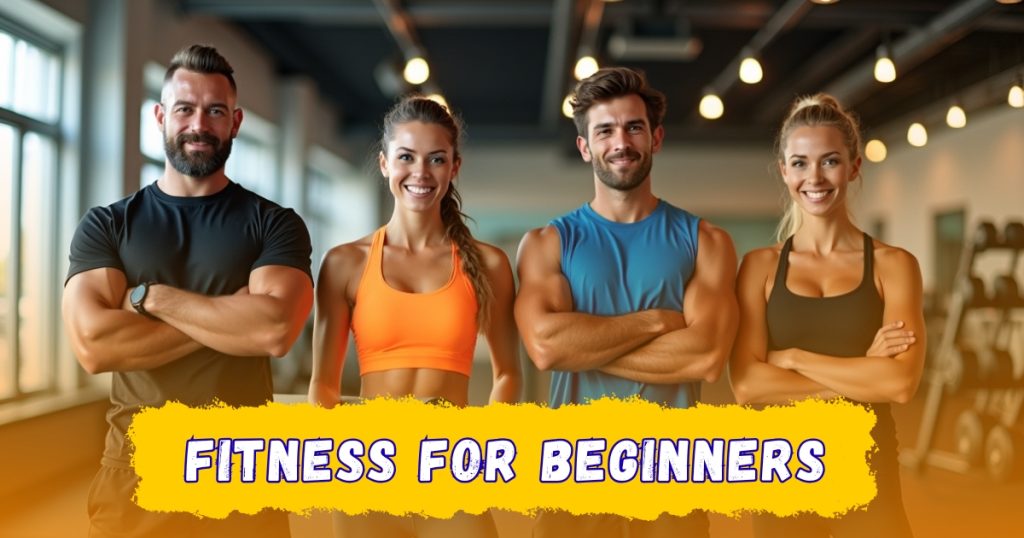Fitness for beginners can be simple and fun. You don’t need to start with hard workouts. Just take small steps that fit your life. Exercise helps you feel stronger and healthier, both inside and out.
In this post, I’ll show you easy fitness activities to try. These beginner exercises will help you build strength and confidence. The key is consistency. As you stay active, you’ll see real progress and enjoy a healthier lifestyle. Let’s get started!
Take care of your body. It’s the only place you have to live
Jim Rohn
Why Fitness is Essential for Beginners

Starting fitness may seem daunting at first. But it’s for everyone. No matter where you begin, the rewards are big.
- Increased Energy
When you first start, you may feel tired. But over time, exercise fills you with energy. It’s like turning on a light. The more you move, the more energy you’ll have for daily tasks. You’ll notice it in everything, from walking to work to playing with your kids. - Better Mental Health
Exercise is like a natural stress reliever. It releases endorphins, which make you feel good. It’s like a breath of fresh air for your mind. After a workout, you’ll feel calmer, less anxious, and ready to face the day. - Improved Sleep
Struggling with sleep? Exercise helps. It helps regulate your body’s sleep cycle. I remember how much better I slept once I started working out regularly. Fitness became my secret for better, deeper rest. - Weight Loss
Fitness for beginners is a great way to shed excess weight. But it’s not only about burning calories. It’s about building habits that last. Whether you walk, run, or do strength training, each movement helps you burn fat and tone muscle. The key is consistency in fitness.
5.Fitness for a Healthy, Long Life
Fitness isn’t just about how you look. It’s about feeling great for years to come. Regular exercise helps reduce the risk of diseases like heart disease and diabetes. It keeps you strong as you age. The more you stick to fitness, the better you’ll feel in the long run.
Types of Exercise to Include in Your Fitness Journey
Now that you know why fitness matters, let’s talk about the exercises that will help you on your fitness journey. No matter your starting point, these exercises are a great fit for everyone.

Aerobic Exercise: Walking, Running, Cycling, Swimming for Cardiovascular Health
- Brisk Walking: This is an easy way to get your heart pumping. It’s great fitness for beginners and can be done anywhere. It’s simple, yet effective.
- Jogging: Start slow, then gradually speed up. It’s a great way to build stamina and endurance.
- Cycling: Whether on a bike outdoors or stationary, cycling strengthens your legs and improves heart health.
- Swimming: A full-body workout that’s easy on your joints. It’s great for building strength and endurance.
Strength Training: Weight Training, Bodyweight Exercises, Resistance Bands for Muscle Strength
- Free Weight Lifting: Using dumbbells or barbells in your fitness for beginners routine engages multiple muscle groups. This approach helps improve muscle strength and endurance, making it a great option for those just starting out on their fitness journey
- Bodyweight Exercises: Push-ups, squats, and lunges can be done at home. These strength-building exercises improve balance and core strength.
- Resistance Bands: A simple, portable way to add resistance to your workouts. They are great for toning and strengthening muscles.
- Machine Weights: For beginners, machines can guide your movements and help you learn the correct form.
Flexibility Training: Stretching, Yoga for Flexibility, and Injury Prevention
- Dynamic Stretching: Before your workout, do leg swings and arm circles to get your muscles ready.
- Static Stretching: After exercising, hold stretches for 20-30 seconds to improve flexibility.
- Yoga: Poses like child’s pose and downward dog stretch and relax your muscles.
- Foam Rolling: This recovery method helps release muscle tightness, improving flexibility and aiding recovery.
Weight Loss Exercises: Activities That Help Burn Fat and Improve Metabolism
- High-Intensity Interval Training (HIIT): Short bursts of intense exercise followed by rest. This method helps you burn fat quickly and boosts metabolism.
- Circuit Training: A series of exercises with little rest. This combines cardio and strength to burn fat and build muscle.
- Jump Rope: A fun, simple way to burn calories. It improves coordination, strengthens the heart, and tones muscles.
- Zumba: A dance-based workout that’s perfect for beginners. It’s fun and effective for burning fat and improving fitness.
https://www.youtube.com/watch?v=_aIYL-KwYpw
Fitness for Beginners: A Simple Guide to Getting Started
Fitness for beginners doesn’t have to be hard or overwhelming. Starting a fitness journey is about taking small, consistent steps. Whether you want to lose weight, get stronger, or simply feel better, a beginner fitness plan can help. The key is to keep it simple, enjoy the process, and build a routine that works for you. Don’t rush – fitness is a long-term journey, not a quick race. Take it one step at a time, and celebrate every little victory.
Before jumping into any exercise plan, it’s smart to check your health. If you have any health issues like high blood pressure or joint pain, talking to a doctor is a must. They can make sure you’re ready and avoid potential injuries. Once you get the green light, you’ll feel more confident about moving forward. Remember, starting slow and listening to your body is the best way to avoid overtraining.
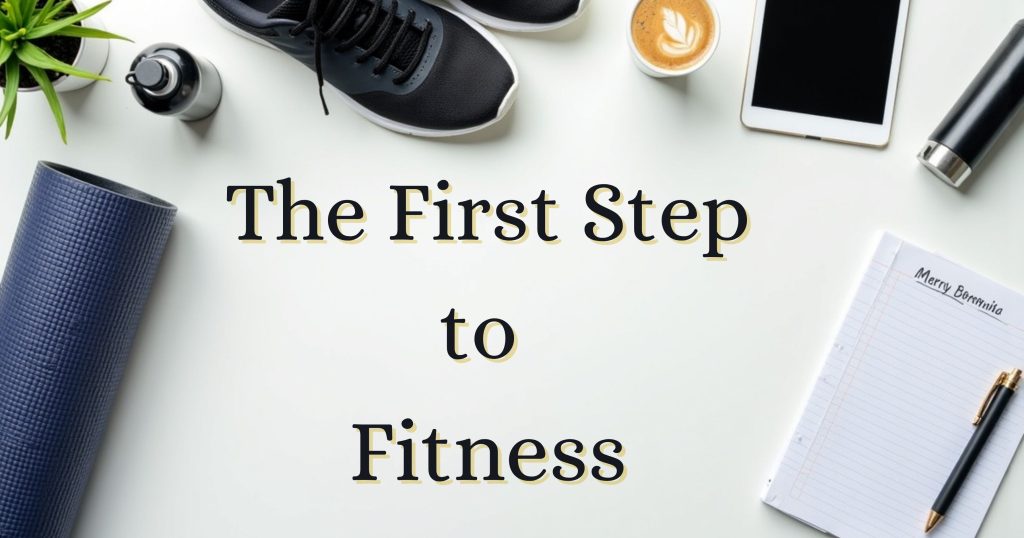
- 1.Check Your Health
Starting exercise is exciting, but it’s essential to ensure your body is ready. If you’ve been inactive or have any health concerns, consulting a doctor is a wise first step. It can help prevent injuries and make sure you’re not pushing too hard. With the right advice, you’ll be set to enjoy your fitness routine safely and effectively. Starting your fitness journey with the right foundation ensures long-term success, especially when you’re focusing on fitness for beginner needs.
2. Create a Fitness Plan for Beginners
The next step is creating a fitness plan. Keep it simple, and make sure it fits your goals. Are you looking to lose weight? Build strength? Or just get moving? Once you know your goal, create a plan that fits your lifestyle. Consistency is the key to success. Whether you prefer working out in the morning or evening, stick to your schedule. Your fitness plan should include strength training, cardio, and flexibility exercises for a balanced approach. When designing your fitness plan for beginners, it’s important to start gradually and increase intensity over time to avoid burnout.
3. Set Realistic Goals
Setting goals is important, but make sure they are achievable. Don’t aim too high right away. Start with short-term goals, like working out for 20 minutes a day, and build up from there. As you progress, set long-term goals, such as losing 10 pounds or running a 5K. Tracking your progress and celebrating small wins will keep you motivated. Fitness is a marathon, not a sprint – take your time and enjoy the ride.
4. Start Small and Build Gradually
It’s easy to get excited about fitness, but don’t go overboard. Starting with too much intensity can lead to burnout or injury. Begin with simple exercises like walking, light jogging, or basic bodyweight exercises such as squats, lunges, and push-ups. As you get stronger, gradually increase your workout time and intensity. This slow and steady approach will help you build endurance and strength without overwhelming your body.
5. Recommended Fitness Routine for Starters
Here’s a beginner fitness plan that works for everyone:
- Beginner Fitness Routine for Men: Focus on simple strength exercises like squats, push-ups, and lunges. Add cardio such as walking or cycling to boost your fitness.
- Beginner Fitness Routine for Women: Strength training is also important for women. Try dumbbell squats, lunges, and resistance band exercises. Add flexibility exercises like yoga or Pilates to improve posture and mobility.
- Fitness Plan for Beginners: A good weekly plan might include three days of strength training, two days of cardio, and two days of flexibility or rest. This balance keeps you on track.
- Fitness for Corporate Professionals: If you work in an office, take short breaks for desk stretches, go for a 15-minute walk during lunch, and do strength exercises on the weekend. This keeps you active without disrupting your work.
- Fitness for Kids: Encourage kids to stay active by running, jumping, and playing sports. Aim for 30-60 minutes of activity 3-4 times a week to help them stay healthy and strong.
A Beginner’s 1-Week Fitness Schedule
Starting your fitness journey doesn’t have to be overwhelming. It’s one of the best decisions you can make for your health. Whether you want to get in shape, lose weight, or simply feel better, a clear fitness schedule for beginners will keep you on track. Here’s a 1-week fitness plan for beginners that combines cardio, strength training, and flexibility exercises—all designed to help you get started safely and effectively. Let’s jump right in!
Fitness for beginners doesn’t have to be complicated. With this simple plan, you’ll gradually build a routine that works for you. It’s about progress, not perfection, and sticking to a balanced approach.
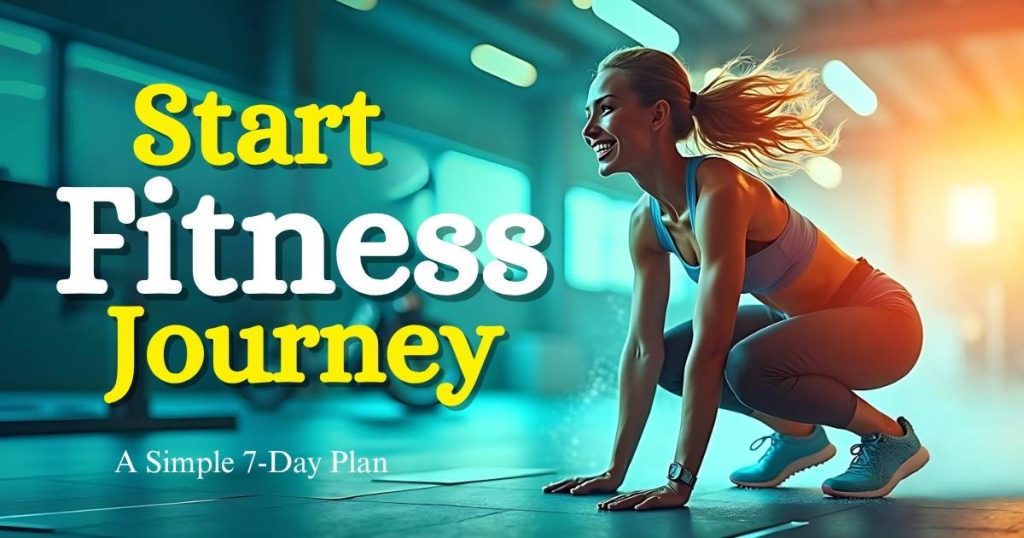
Day 1: Full-Body Workout with Cardio and Bodyweight Exercises
Fitness for beginners starts with building momentum. Day 1 is about getting your body moving. I love starting with a full-body workout because it activates everything without feeling overwhelming.
Here’s a simple start: Begin with jumping jacks to get your heart pumping. Do this for about one minute. Next, move on to push-ups, squats, and planks. These are great for beginners and help you learn how to use your body. The goal here is consistency, not perfection. You’re laying the foundation for your fitness routine for starters. Keep it up!
Day 2: Light Cardio (Walking or Cycling) and Flexibility Training (Yoga or Stretching)
By Day 2, your body needs a break from intense work. But you can still stay active. Fitness for beginners is about balance. I love walking or cycling because they’re easy on the body and help with recovery.
After your walk or cycle, spend 10-15 minutes on flexibility training. This could be a few stretches or a short yoga session. Stretching improves flexibility and prevents injuries, especially when you’re starting out. Think of it as an investment in your future workouts. The more flexible you are, the easier it will be to do tougher exercises down the road.
Day 3: Strength Training (Lower Body) with Squats, Lunges, and Leg Presses
Day 3 is all about strength training. Don’t worry, this doesn’t mean heavy lifting! It’s about building strength in a way that supports your everyday movements. I started with squats and lunges. They work your legs and core.
If you have access to a gym, leg presses are a great addition. These exercises engage multiple muscles and help with balance—key when you’re just starting. They’re beginner strength exercises that’ll make you feel strong and confident.
Day 4: Rest Day or Active Recovery (Easy Walk, Stretching)
Rest is as important as the workout. On Day 4, your muscles need to recover. But rest doesn’t mean doing nothing. I recommend a light walk or some gentle stretching. This keeps your muscles active and helps with recovery.For beginners, incorporating active recovery into your fitness routine can improve your overall progress. It’s a great way to stay consistent in your fitness for beginners journey without overtraining.
I know it feels tough to rest, especially when you want to keep going. But trust me, taking this time to recharge will help you come back stronger on Day 5. Active recovery is key.
Day 5: Upper Body Strength Training with Push-ups, Dumbbell Exercises, and Resistance Bands
Day 5 targets the upper body. Strengthening the upper body is not just about building muscles; it also improves posture and overall strength. Start with push-ups—they’re perfect for building chest, arm, and core strength.
Add some dumbbell exercises like shoulder presses and bicep curls. Resistance bands are great too, as they provide tension to work your muscles even with lighter weights. Focus on proper form—it makes all the difference. As you get stronger, you’ll notice significant improvements in your overall fitness.
Day 6: Cardio Workout (Jogging, Swimming, or Cycling)
By now, you’ll feel stronger, and it’s time for cardio. I recommend jogging, swimming, or cycling. These are excellent ways to improve heart health and burn fat.
Pick an activity you enjoy! When you like what you’re doing, it won’t feel like a chore. Aim for 30-45 minutes at a steady pace. Over time, you’ll notice improvements in your endurance and energy levels. Keep pushing forward!
Day 7: Rest or Flexibility Training (Focus on Recovery)
You’ve made it to the last day! On Day 7, it’s time to relax and recover. You’ve worked hard all week, so take a break. If you feel up to it, you can do some flexibility training or gentle yoga.
The goal today is to allow your muscles to recover while staying active. I found that focusing on recovery kept me from feeling sore and helped me feel refreshed for the week ahead.
This fitness schedule for beginners is designed to help you ease into a consistent routine. Don’t rush the process—progress takes time. The secret to success is patience and consistency.
Whether you’re using this plan for weight loss or just starting your fitness journey, this schedule will guide you every step of the way. Keep moving forward, and I promise you’ll feel stronger, more energized, and ready to tackle the next challenge.
How Much Time Should You Exercise Each Week?
When I first started working out, I was bombarded with advice about how much time I should be spending exercising each week. It felt like everyone had their own opinion on what works best, and honestly, it was overwhelming. But here’s the truth: you don’t need to overthink it, especially when you’re just starting out with fitness for beginners. The goal is to find a balance that works for you and keeps you moving. Let’s break it down together in simple terms.
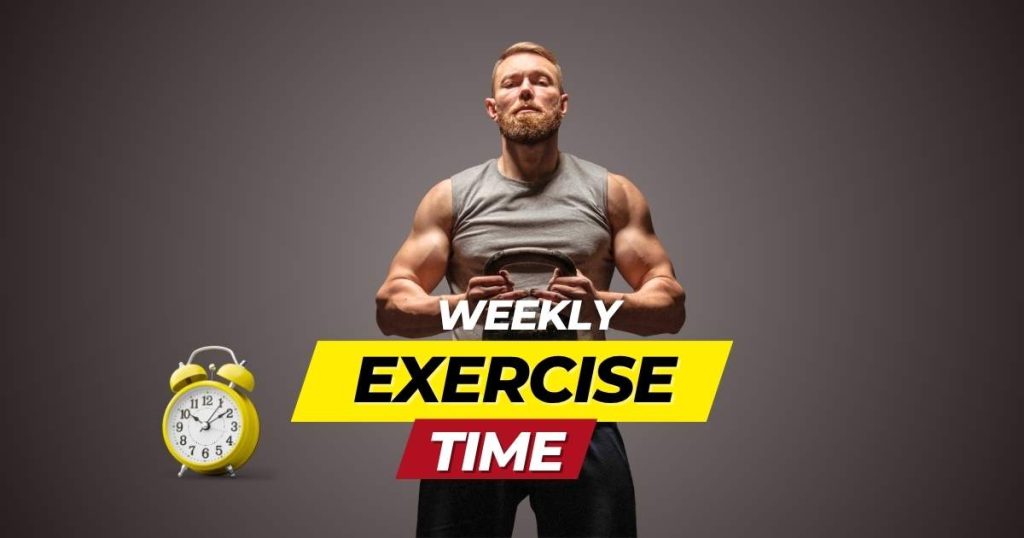
General Recommendations
It’s simple: aim for 150 minutes of moderate exercise each week. That could be as easy as walking or cycling—activities anyone can fit into their day. If you’re up for more intensity, try 75 minutes of vigorous exercise like running or HIIT.
When I first started my fitness for beginners plan, I didn’t worry about hitting these numbers right away. I started slow, walking 30 minutes a day. Over time, my stamina grew, and so did my confidence. The key? Consistency. You’ll build endurance, step by step.
Fitness Schedule for Beginners: How to Divide Your Workout Time
One of the hardest parts when I began was figuring out how to structure my week. I had no fitness background, so it took time to find a rhythm. The trick is to balance your fitness schedule for beginners. You want to build strength without burning out.
Here’s how I planned my week:
- 3 to 4 workout days per week: This gives your body time to rest and recover.
- On cardio days (walking or cycling), I kept it light. This keeps your heart healthy and your body active.
- On strength training days, I focused on beginner fitness routines like squats, lunges, and push-ups. These simple exercises helped me build strength without needing fancy gym equipment.
It’s all about finding that sweet spot. Start slow and gradually adjust your fitness routine for starters to fit your goals—whether it’s weight loss or gaining muscle. The key is consistency.
Fitness Motivation: How to Stay Consistent
We all know those days when motivation is low. I’ve had them, too. But staying committed to your fitness for beginners schedule comes down to staying motivated—even when you don’t feel like it
For me, fitness motivation was about making things easy. Instead of aiming for an hour at the gym, I told myself, “I’ll just do 15 minutes.” And you know what? Once I started, I always went longer.
It’s all about momentum. The more you show up, the easier it gets. When I started, my beginner fitness routine for Man was just simple bodyweight exercises. It didn’t feel like much at first, but it was a huge win for me to stick with it.
How to Balance Exercise and Recovery
One thing I quickly learned is how crucial recovery is. A fitness plan for beginners isn’t just about going hard every day. You need to give your body time to rest and rebuild. That’s when the real strength happens.
I always made sure to take one or two rest days a week. These were days for light stretching or yoga. It kept me flexible and feeling good. If you’re sore, it’s okay to take a break. Recovery is just as important as the workouts.
Consistency is Key
Here’s the secret: staying consistent with your fitness for beginners schedule is what matters most. It’s easy to feel like skipping a workout. But remember, even on those days when you don’t feel like working out, showing up counts.
Whether it’s a short walk or a quick stretch, stay consistent. Over time, those small actions add up to big results.
This approach to a fitness plan for beginners isn’t about pushing yourself until you’re exhausted. It’s about starting small, building momentum, and gradually increasing intensity. Whether you’re focused on weight loss or just feeling better in your body, it’s all about taking those first steps and staying consistent. You’ve got this!
Key Tips for Fitness Motivation and Success
Starting a fitness journey can seem challenging at first. But if you take the right approach, it gets easier. These simple tips will help you stay motivated and see real progress along the way. Let’s break down what works for fitness for beginners and how to make it part of your life.
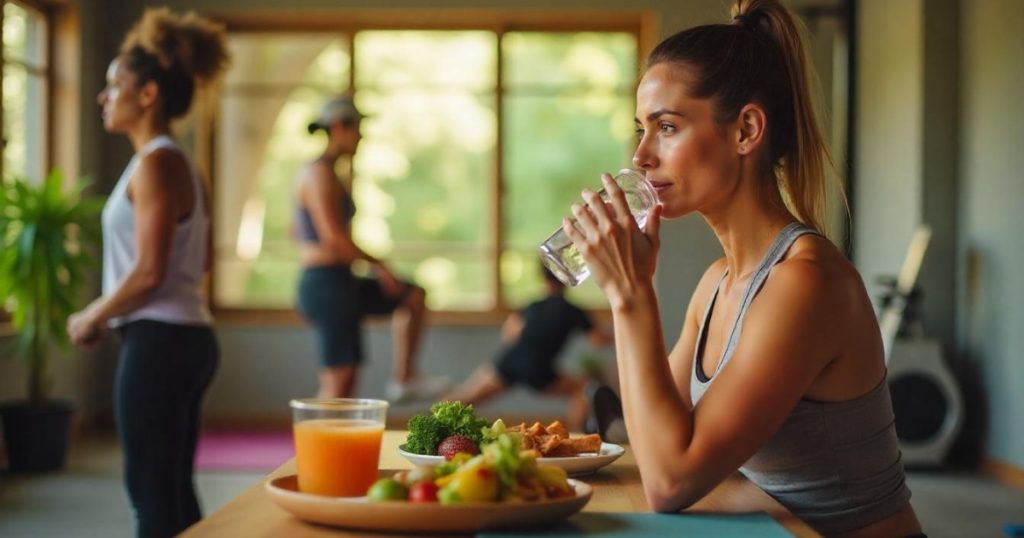
Stay Hydrated: Why Water is Essential Before, During, and After Workouts
Water is essential for your body to work well. Think of it as the fuel your muscles need to perform. Without water, your muscles don’t perform at their best, and recovery slows down.
- Hydration for fitness keeps your body energized and your muscles strong.
- Drink water before exercise to get your body ready. Post-workout hydration helps your muscles recover.
- Staying hydrated also aids muscle recovery, helping you feel better after workouts.
Tip: Keep a water bottle nearby and drink small sips throughout your workout. It helps you stay hydrated and feel good.
Optimize Your Nutrition: The Role of Nutrition in Fitness and Weight Loss
What you eat is as important as how you move. The right food fuels your body and helps it recover faster. Without the right fuel, your body can’t perform at its best.
- Nutrition for fitness gives you the energy you need for exercise.
- Protein intake for muscle growth is key, especially after strength training.
- A balanced diet for fitness with the right mix of carbs, proteins, and fats helps keep your body working at its best.
Tip: Plan your meals around your workout. Eating a mix of proteins, healthy fats, and carbs will give you energy and help you recover.
Warm-Up and Cool Down: Importance of These for Injury Prevention and Recovery
Warming up and cooling down might seem optional. But they’re crucial for avoiding injury and speeding up recovery. Think of it as preparing before and relaxing after a long day of work.
- Warm-up for workouts helps get your muscles ready and reduces injury risk.
- Cool-down exercises let your muscles relax and help prevent soreness after your workout.
- These recovery methods improve flexibility and keep your muscles safe.
Tip: Spend 5–10 minutes warming up before and cooling down after your workouts. It’s a small effort that pays off big.
Listen to Your Body: How to Avoid Overtraining and Recognize Signs of Fatigue or Injury
Your body speaks to you. If you’re tired or sore, it’s telling you to rest. Overtraining can lead to injury and burnout, so it’s important to listen.
- Overtraining signs include feeling constantly tired or sore. Rest is important when these signs appear.
- Fitness rest days are just as important as your workout days. They help muscles recover.
- Fatigue during exercise means your body might need a break.
Tip: If you feel tired or sore, take a rest day. It’s better to rest and come back stronger.
Overcoming Fitness Challenges for Beginners
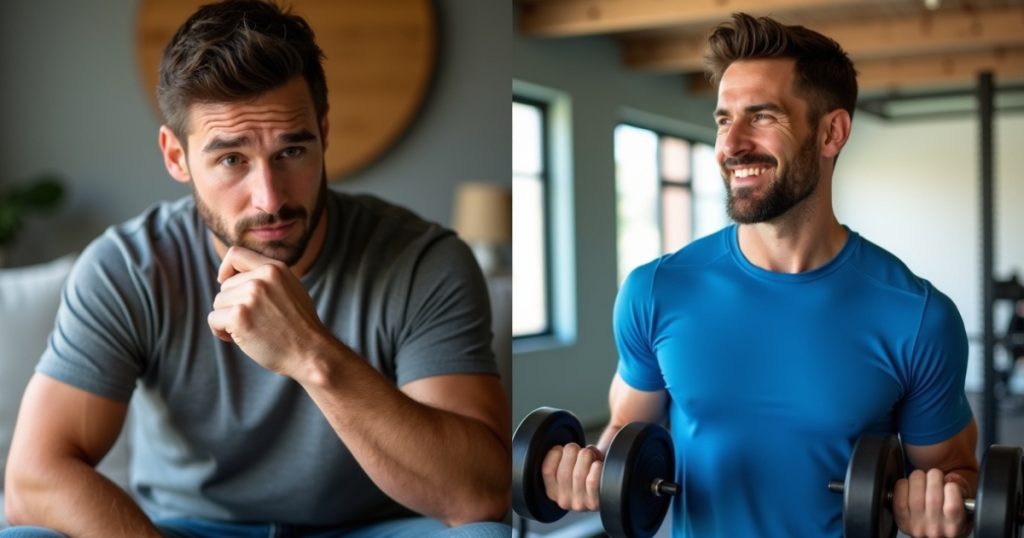
Every beginner faces challenges. The key is to stay consistent and keep moving forward. Here’s how to overcome common obstacles in your fitness journey.
Consistency is the most important thing for success. It’s about showing up every day, even if it’s just for a short time. The more you stick to a routine, the easier it becomes.
Building a fitness habit starts small. Begin with easy, short workouts and work your way up. A daily workout routine helps you stay on track, even on busy days.
Tip: Set a regular time for your workout. Treat it like an important part of your day.
Fitness for beginners often starts with small, manageable goals, but the key is persistence. As you progress, you’ll notice improvements, which will keep you motivated.
Staying Motivated: Tips for Setting Rewards and Tracking Progress
It’s normal for motivation to dip. Tracking your progress can help keep it high. Celebrate small wins and reward yourself when you reach milestones.
Fitness for beginners motivation stays strong when you can see progress. Track your workouts to see how much you’ve improved.
Fitness goal setting gives you something to focus on. Break big goals into smaller steps.
Reward systems for fitness keep you motivated. Celebrate milestones with small rewards.
Tip: Use a fitness app or journal to track your progress. Celebrate small milestones with rewards to stay on track.
Dealing with Setbacks: How to Stay Positive After a Missed Workout or Challenge
Setbacks happen, but they don’t define your progress. Missing a workout doesn’t mean failure—it’s just a small bump in the road.
Overcoming fitness setbacks means accepting them and refocusing on your goals.
Fitness resilience helps you bounce back and stay focused.
Staying positive after missed workouts keeps you on track.
Tip: If you miss a workout, don’t dwell on it. Start again the next day and keep moving forward.
Small, steady efforts will lead to big results. Keep moving forward—you’ve got this!
Common Mistakes Beginners Make and How to Avoid Them
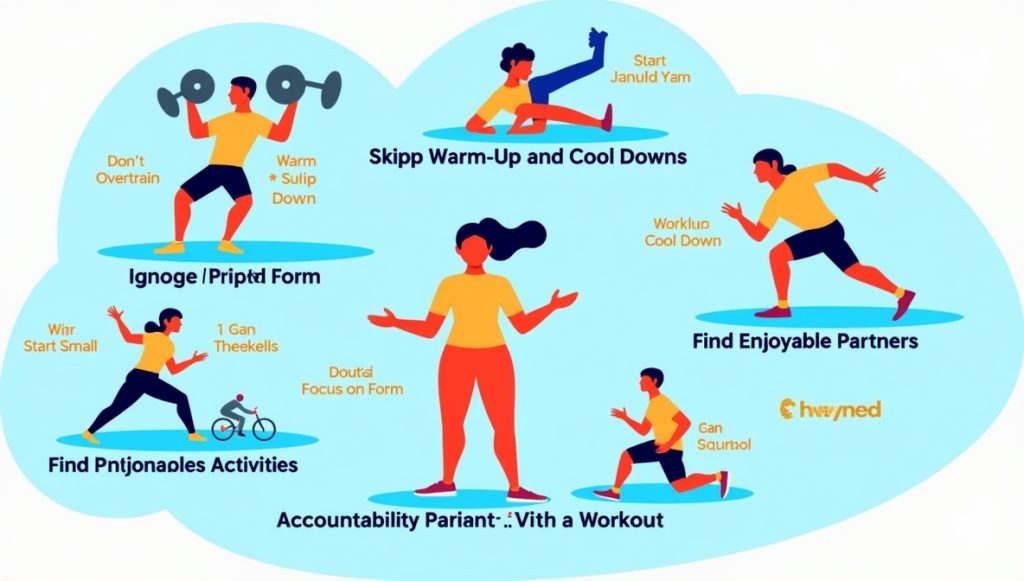
Overtraining: The Dangers of Pushing Too Hard, Too Fast
It’s tempting to do a lot at once, but overtraining can lead to burnout or injury. If you push too hard without rest, your body can’t recover. To avoid this, follow a fitness for beginners plan with rest days. Start slow and let your body recover. It’s important for long-term progress.
Skipping Warm-Ups and Cool Downs: Why This Can Lead to Injuries
Skipping warm-ups and cool-downs can lead to injury and soreness. Warm-ups get your muscles ready for exercise, while cool-downs help you recover. Always take 5-10 minutes to warm up before and cool down after your workout. This simple habit can help prevent injuries and make your workouts more effective.
Ignoring Proper Form: Importance of Correct Form to Avoid Injury
Poor form during exercises is one of the easiest ways to get hurt. It’s easy to rush, but using the wrong form can strain your joints and muscles. Focus on learning the correct techniques first, then gradually increase intensity. Slow down and ask for help if needed. Proper form is key to preventing injuries and getting the best results.
How to Make Exercise a Sustainable Habit
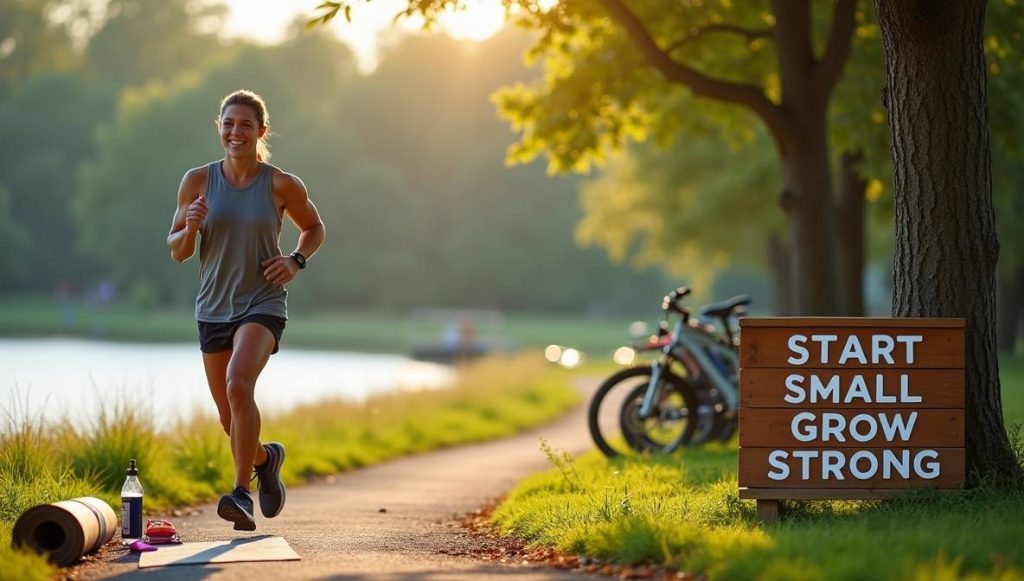
Start Small: How to Ease into Fitness and Increase Intensity Gradually
If you’re new to exercise, start small. Begin with short, simple workouts and slowly increase the time and difficulty. A fitness schedule for beginners should be easy to follow and not too overwhelming. As you improve, you can increase the intensity, but always keep it manageable.
Find Enjoyable Activities: The Importance of Enjoying Your Workouts
The best way to stick with exercise is to enjoy it. If you don’t like running, try cycling, swimming, or dancing. A weight loss fitness plan for beginners should include activities that make you excited to work out. When you enjoy your workouts, it’s easier to stay consistent and motivated.
Accountability Partners: How Exercising with a Friend or Joining Fitness Communities Can Help Keep You on Track.
One of the best ways to stay motivated is by having an accountability partner. Whether it’s a friend, family member, or a fitness community, exercising with someone else can keep you on track. You can motivate each other, celebrate milestones, and push through tough days together. It’s amazing how much easier it is to stay consistent when you’re part of a supportive group.
Fitness for beginners doesn’t have to be complicated. By avoiding overtraining, skipping warm-ups, and ignoring form, you’ll set yourself up for success. Start small, stay consistent, and find activities you enjoy. Over time, fitness will become a natural part of your routine. Listen to your body, and most importantly, enjoy the journey to a healthier you. You’ve got this!
Best Exercises for Weight Loss and Fitness for Beginners
When I first started working out, I had no idea where to begin. I wanted to lose weight, get stronger, and just feel better. But it wasn’t easy. So, I took it slow and started with simple exercises. Let me share what worked for me.
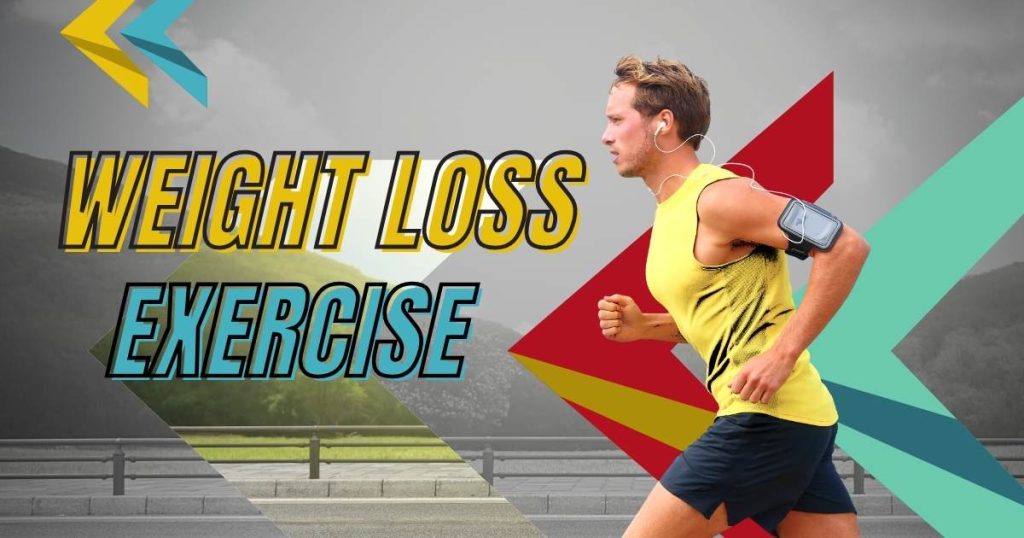
Beginner Fat-Burning Exercises: Simple Moves to Help Burn Fat
The first thing I did was focus on simple exercises that burn fat. I started walking. It was easy and didn’t require much effort. Walking 30 minutes a day really helped me get moving.
Then, I added cycling. Whether it was outdoors or on a stationary bike, I enjoyed it. It wasn’t too hard, but it helped me burn calories.
I also did bodyweight exercises like squats, lunges, and push-ups. These exercises were great for fat loss and easy to do anywhere. No equipment needed. They worked my whole body and got me stronger over time.
Starting with these simple exercises made it easy for me to stay on track. I didn’t push too hard, but I kept going every day, which is key when it comes to fitness for beginners.
Strength Training for Women Beginners: Building Muscle and Boosting Metabolism
Strength training was a game-changer for me. I used to think it was just for bodybuilders. But I was wrong. For fitness for beginners female, it’s one of the best ways to lose fat and build muscle.
I started with simple moves like squats and push-ups. These exercises use your own body weight, so you don’t need any fancy equipment. I noticed my legs and arms getting stronger after just a few weeks.
I also added dumbbell exercises. Shoulder presses and bicep curls helped tone my arms. I could feel my metabolism picking up, even when I wasn’t working out.
Strength training gave me more energy, and it helped me burn fat faster. The more muscle you have, the more calories you burn at rest. That was a huge win for me.
Weight Loss Fitness Plan for Beginners: Combining Cardio and Strength Training
To lose weight and get fit, I needed to combine both cardio and strength training. A good weight loss fitness plan for beginners should have both. Cardio helps you burn calories, and strength training helps you build muscle.
I walked or cycled on cardio days. Just 30 minutes, 3-4 times a week. It kept my heart healthy and helped me burn fat.
On strength training days, I did bodyweight exercises like squats, lunges, and push-ups. These worked my whole body and built muscle. I also added dumbbell exercises to target specific muscles.
The key is balance. Too much cardio can wear you out. Too much strength training can be hard on your body. A mix of both gave me the best results. I felt stronger, healthier, and more energized.
If you’re just starting, don’t overthink it. Begin with simple fat-burning exercises like walking, cycling, and bodyweight circuits. Add strength training to build muscle and boost metabolism. Combine both for the best results. Stay consistent, and you’ll see changes over time.
Whether your goal is weight loss or just feeling better in your body, the journey is worth it. Keep going, and remember, progress takes time.Fitness for beginners is all about making small, sustainable changes that add up over time.
Legal Disclaimer
The advice provided here is intended for individuals starting their fitness for beginners journey. It’s important to consult with a healthcare professional before starting any fitness plan, especially if you have existing health issues. Always listen to your body and adjust your routine as needed for safe progress.
Conclusion
Starting fitness for beginners is easier than you think. Just stick to simple workout routines and stay consistent. Whether you’re aiming for weight loss or just feeling better, small steps make a big difference. Keep yourself motivated and enjoy the journey. You’re doing great – every little effort brings you closer to your goal. Keep it up, and celebrate the progress you make along the way!

